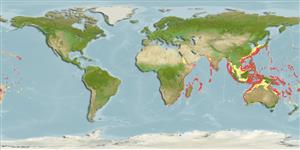Elasmobranchi (squali e razze) (sharks and rays) >
Myliobatiformes (Stingrays) >
Plesiobatidae (Deepwater stingrays)
Etymology: Plesiobatis: Greek, plesios = near + Greek, Greek, batis, batidos = a ray (Raja sp.) (Ref. 45335).
Environment: milieu / climate zone / depth range / distribution range
Ecologia
marino batidemersale; distribuzione batimetrica 44 - 780 m (Ref. 58302), usually 275 - 680 m (Ref. 9914). Deep-water; 39°N - 37°S, 20°E - 154°W
Indo-Pacific: South Africa, Mozambique, southern India, east to the Philippines (Ref. 5281), north to Japan and south to Australia. Also reported from the Hawaiian Islands.
Length at first maturity / Size / Peso / Age
Maturity: Lm 194.5, range 189 - 200 cm
Max length : 270 cm TL maschio/sesso non determinato; (Ref. 3263)
Spine dorsali (totale): 0; Raggi dorsali molli (totale): 0. A giant plain stingray with a broadly pointed snout, small eyes and a round disc; tail short with a long caudal fin and a narrow sting; upper surface covered with denticles (Ref. 5578). Grey-black to brownish or purplish-brown above, white below; rear edges of pelvic fins and tail grey; disc edges black, and sting light (Ref. 5578).
Found on the outer shelf and upper slope (Ref. 5578), on soft bottoms (Ref. 9914) at depths of 275-680 m (Ref.58048). Benthic (Ref. 58302). Feeds on small pelagic fish, eels, crabs, shrimp, lobsters, cephalopods and polychaete worms (Ref. 5578). The specimen taken from a depth of 44 m was caught off Mozambique (Ref. 9914). Its sting is long and can inflict a painful wound if handled. Caught occasionally by demersal longline fisheries in deepwater. Utilized for its meat, but not of a particularly high value (Ref.58048).
Life cycle and mating behavior
Maturità | Riproduzione | Deposizione | Uova | Fecundity | Larve
Nishida, K., 1990. Phylogeny of the suborder Myliobatidoidei. Mem. Fac. Fish. Hokkaido Univ. 37(1,2) (serial no. 54):1-108. (Ref. 7444)
IUCN Red List Status (Ref. 130435)
Warning: mysqli::__construct(): (HY000/1040): Too many connections in /var/www/html/includes/func_getlabel.php on line 46
Can't connect to MySQL database (fbapp). Errorcode: Too many connections
